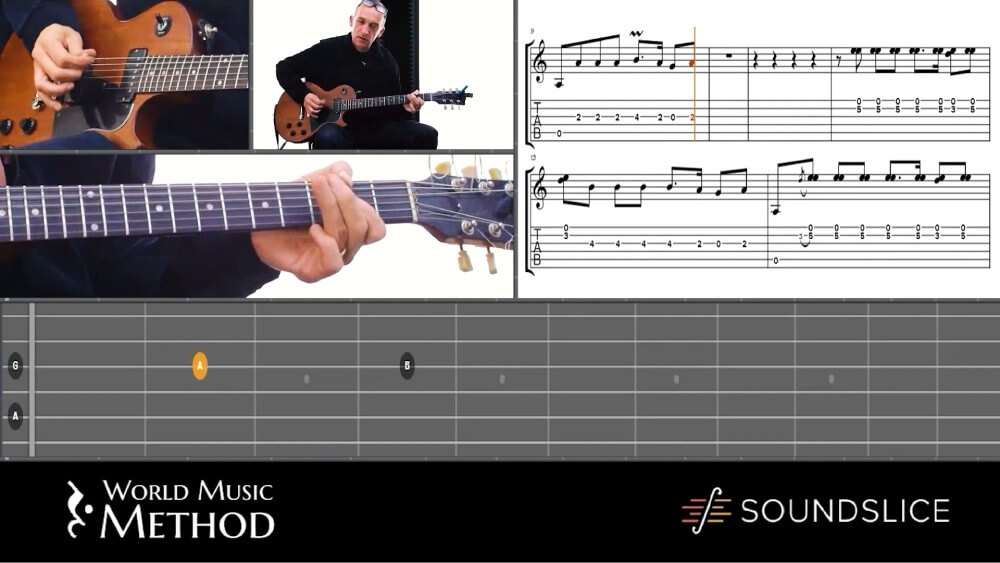enrich your repertoire
Desert Blues – The Sound Of The Sahara
Imagine traveling from the Middle East into Africa. What sound would you be hearing as you encountered nomadic caravans camped at each desert oasis? Likely it would be desert blues, a music both ancient and contemporary, a guitar style that is beautifully haunted yet capable of wild, spontaneous improvisation and intense rhythmic groove.
In these remote lands, often torn apart by conflict, music brings people together: the Festival in the Desert in Northern Mali existed as the most exciting celebration of guitar-based music anywhere. Here musicians from across the world gathered to hear and learn desert blues guitar. This elemental sound blends the Tuareg musicians of the Sahel region with the mystical healing tones of the Moroccan gnawa and the African timbre found in the ancient and beautiful music of Mali, Senegal and Mauritania. Shaped by ancient civilizations, the very basis of blues and jazz, rock and trance, a sound that inspires souls to fly.
One thousand years of North African history…..plugged into an amplifier.
Key Learning Outcomes
Upon successful completion of this course, participants will be able to:
Master North African Rhythms
- Play fundamental North African and desert guitar grooves, including Darabuka and 6/8 rhythms.
- Develop a strong sense of timing and phrasing within traditional rhythmic structures.
Perform Desert Blues and Sufi Music
- Learn and interpret classic desert songs such as Sidi Mansour, Ighzayel Mayel, and Zahir Teneray.
- Adapt these melodies with authentic phrasing and rhythmic variations.
Apply Unique Guitar Tunings and Techniques
- Explore traditional desert guitar tunings, including those used by Tinariwen and other Tuareg musicians.
- Utilize desert-inspired techniques to create fluid, hypnotic guitar lines.
Understand Moroccan and Gnawa Musical Traditions
- Study the cultural and musical significance of Gnawa music and its connection to trance-like rhythms.
- Incorporate Moroccan and Gnawa influences into your own playing.
Integrate North African Styles into Contemporary Music
- Fuse desert blues techniques with modern guitar styles for a richer musical vocabulary.
- Expand your improvisational approach by incorporating Saharan phrasing and microtonal ornamentation.
Enhance Your Practice with Additional Learning Tools
- Utilize backing tracks, ebooks, and masterclass recordings to refine your understanding of North African guitar traditions.
Sample Lessons
Meet Your Tutor: Justin Adams

Justin Adams needs little introduction, he being one of Britain’s master guitarists - whether he’s Robert Plant’s right-hand man or Jah Wobble’s foil, producer of Tinariwen and Rachid Taha, a studio collaborator with the likes of Brian Eno and Sinead O’Connor, half of the JUJU duo with Gambian griot Juldeh Camara or joining Ben Mandelson and Lu Edmonds in maverick folk trio Les Triaboliques.
Adams' long connection with the music emanating from the Sahara and North Africa has ensured that he is amongst the most influential electric guitarists of the 21st Century. Just as his British forefathers Jeff Beck and Eric Clapton picked up on US blues and rockabilly to pioneer new levels of dynamic improvisation in rock guitar, Adams’ immersion in (and understanding of) the music of the Berbers and Tuareg - who roam the Sahara - and the griots of Africa has literally expanded and enriched the electric guitar’s sonic palette.
Born in London and spending his early childhood years in Egypt - his father was a diplomat - Adams grew up loving both the British pop/rock music he heard on the BBC and the North African music encountered on the streets and souks of Cairo. As a young guitarist back in Britain it was his ability to blend elements of both musical cultures that made him such a distinctive musician and an in-demand player for visionary producers and band leaders who wanted to step outside convention.
The Ultimate Learning Experience

Desert Guitar - Origins
Absorb the rhythms of North Africa and the Sahara then learn about the guitar approaches from Moroccan, Algerian, Tunisian, Malian and Egyptian genres in this 1 hour 40 minute course.

Interactive On-screen Notation
Our state of the art learning technology speeds up studying with innovative, interactive tools. Access on-screen notation, tablature, animated fretboards, variable tempos, and more today.

Masterclass
Receive your invitation to the next live masterclass and Q&A and gain immediate feedback and answers from Justin Adams.

North African Backing Tracks
Put your new techniques into practice and jam with Justin over traditional North African guitar grooves so you can develop your own authentic feel and be confident playing in a variety of new styles.

Sounds Of The Sahara – Ebook
Through a collection of articles by Andy Morgan learn about the different artists pioneering Saharan guitar music.









Hello,
Will I get access to the tablature, which is downloadable and printable?
Is it possible for left handed to follow?
Is an electric guitar necessary? I only have classic acoustic guitar.
Hi. You can download and print the tablature and notation or view it on-screen synced to the video. On any lesson just click on the media player’s settings in the bottom right corner of the media player and click Print then you can save as PDF or print.
For left handed guitarists there is a button on the media player which switches to mirrored view which was designed specifically for left hand guitarists. Press that and everything will be in left handed view.
Any electric, acoustic or classical guitar would be fine to follow this course.
Yes you get tablature and notation which is printable. There is a button on the video player which flips the screen for a left handed guitarists view. Acoustic guitar is fine and will sound nice.
Hello, I am interested in this course as I love Tuareg guitar. However, I am a very beginner…I have played the guitar for about 1 year, trying to larn spanish guitar own my own and know a little bit of sheet music. That is it. What do you think in terms of the course being useful for me? Also does the course offer the actual sheet music / tab to print off? Thanks for enjoyig and offering such awesome music. NuWa
Hi. All the courses have guitar tab and sheet music. It’s got on-screen synchronized to the video but also can be printed. You sound like a keen student and have probably progressed a lot in your first year and unless you push yourself you won’t continue to improve rapidly. Buy this course and send me a message when you’ve done it (click on my profile image and you can then send me a message) and then I’ll give you a full beginners guitar course for free which you’ll love.
Hello. I’ve really been interested in Tuareg music recently and want to learn to play it but the problem is I don’t have any experience with the guitar. I just got an acoustic guitar purposely for learning the Tuareg music. Does the course consider absolute beginners ?
Hey Charles. We have another course which would be perfect for you to first called Guitar Technique Library https://worldmusicmethod.com/courses/guitar-technique-library/
If you get started on this course you’ll get comfortable on the guitar and then be ready to learn Tuareg music and Justin’s course will be a great place to start.